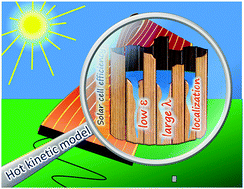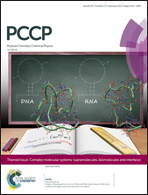Hot kinetic model as a guide to improve organic photovoltaic materials†
Abstract
The modeling of organic solar cells (OSCs) can provide a roadmap for their further improvement. Many OSC models have been proposed in recent years; however, the impact of the key intermediates from photons to electricity—hot charge-transfer (CT) states—on the OSC efficiency is highly ambiguous. In this study, we suggest an analytical kinetic model for OSC that considers a two-step charge generation via hot CT states. This hot kinetic model allowed us to evaluate the impact of different material parameters on the OSC performance: the driving force for charge separation, optical bandgap, charge mobility, geminate recombination rate, thermalization rate, average electron–hole separation distance in the CT state, dielectric permittivity, reorganization energy and charge delocalization. In contrast to a widespread trend of lowering the material bandgap, the model predicts that this approach is only efficient along with improvement of the other material properties. The most promising ways to increase the OSC performance are decreasing the reorganization energy, i.e., an energy change accompanying CT from the donor molecule to the acceptor, increasing the dielectric permittivity and charge delocalization. The model suggests that there are no fundamental limitations that can prevent achieving the OSC efficiency above 20%.



 Please wait while we load your content...
Please wait while we load your content...